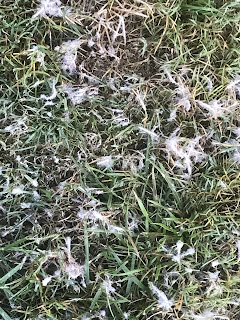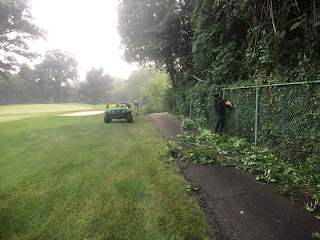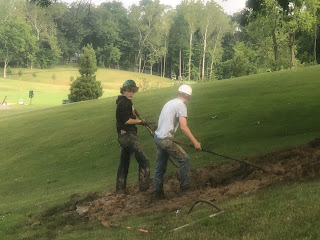Summer Conditions are Never Perfect
The tri-state area has switched from a hot and dry June to a hot, dry and humid July. Surprisingly, we are still dealing with dry conditions-the U.S. drought map has southern Ohio under a moderate drought. Despite the recent light rainfalls, we are still behind on precipitation over the last couple months. With daily evapotranspiration rates around a quarter inch, most light rain events are quickly used up by plants or evaporate into the atmosphere. This has kept our irrigation system busy. Also, the high humidity has lead to an increase in spray applications to keep the summer time diseases in check. Ultimately, it is never perfect conditions in the summer for the cool-season turf (which most of the golf course is composed of). If it is too dry a struggle ensues to keep enough moisture in the ground, if it is too wet the challenge is to keep the diseases at bay. Or, as is the current situation, the crew is trying to irrigate to supplement moisture loss in addition to increasing spray applications during this very humid stretch. This is the toughest time of the year for the WHCC turf and adding in the copious amounts of poa annua that thrive in this shaded golf course make it an even bigger challenge. Currently, the golf course is in great shape; however, having experienced many WHCC summers, I know how quickly conditions can deteriorate. As we advance deeper into the summer months the grounds crew will strive to keep the turf alive with acceptable playing conditions.
 |
| Tree roots sucking up all the moisture behind #12 tee. This picture is from last season. Eliminating one of the two pin oaks over the winter has helped to decrease the amount of stressing/dead grass in this location. |
 |
| A picture from last season. Poa annua dying out in late July on #9 fairway. The increased shade caused the poa to thrive in this area. Poa can not tolerate extreme heat and will die if these conditions persist. |
 |
| Pythium blight outbreak in the rough. Picture was from August of 2020. |
 |
| Poa annua dying out, left of #7 fairway in 2019. |
 |
| A localized dry spot forming on #12 green this year. |
 |
| Chris Wheeler spraying tees-trying to keep the summer disease at bay. |
Green Speed
July
is typically a month when we receive many questions about green speed. When the
heat and humidity tick up, the distance the ball travels decreases (Here is a link to an article from the USGA that explains the variations in green speed throughout the season). We are within the WHCC standard range for green speed; however, current and past stimpmeter readings have shown that the greens are usually at the lower end of the range during the heat of the summer and
higher during the cooler months. During the summer, humid conditions cause the turfgrass plant to literally swell with moisture, increasing resistance when the golf ball rolls. In addition, the hot soil temperatures increase microbial activity, thereby increasing turfgrass growth and slowing down speeds. We spray PGRs to combat the growth, based on clipping yield measurements, but it is definitely a challenge to get the sprays down during the busy golf calendar.
Balancing the speeds with trying to keep healthy turf is another added challenge. The environmental conditions dictate how aggressive we can be with height of cut, decreasing irrigation, increasing rolling frequency, and PGR applications (Click here for a previous blog post on factors influencing green speed-The Need For Speed). Ultimately, we have to keep the turf alive and healthy to perform well throughout the long golf season. Pushing to increase speeds for daily play during stressful environmental conditions is not recommended for quality putting surfaces. Knowing when to pump the brakes for aggressive practices is a necessary skill that involves data, science, and experience. For tournaments, we will push the limits on the turf to achieve faster speeds; however, once the tournaments conclude, the turf needs time to recover. Overall, I believe the WHCC greens are performing very well. Continuing to implement weekly cultural practices, such as verticutting, PGR applications, venting, and topdressing will continue to improve turfgrass health. Healthier turf will allow for more aggressive practices that will eventually lead to faster greens. Hopefully, everyone understands that speeds will fluctuate, especially during the summer, in order to keep the greens healthy.
 |
| Assistant Michael Westendorf measuring green speed on #5 green. |
 |
| 2nd Assistant Chris Wheeler venting the putting green extension. |
Bees in Bunkers
Over the last couple of years small wasps have begun to buzz around some sand bunkers. They are smaller than the usual suspect, the cicada killer wasp, but tend to look almost identical. I'm not an entomologist, but my best guess is these are sand wasps (Bicyrtes quadrifasciatus). Joe Boggs, Ohio State Extension entomologist, wrote an article about these wasps a couple years ago when he found them at White Oak Garden Center (click here for the article). They feed off of brown marmorated stink bugs and are also named stink bug hunters. Like cicada killers, they are solitary wasps that are not aggressive and rarely sting. They dig burrows into sandy soils, making bunkers a perfect environment. Chemical control is difficult because the wasps are scattered out into many different burrow colonies. Daily raking of the bunkers helps to keep the populations down, but the wasps are extremely difficult to fully eliminate. We have made some pesticide applications; however, they eventually resurface. Sand wasps are technically a beneficial insect, and are not a threat to stinging humans. We will continue to frequently rake the sand traps, and if this year is similar to the past, they will eventually move on.

Miscellaneous Jobs
Many behind the scenes jobs get accomplished during the summer months These include trimming irrigation heads, trimming back brush along the fence lines, fixing irrigation leaks, pulling weeds, and edging bunkers. These jobs are completed in addition to the daily maintenance and course set-up. These tasks are an important part of keeping the WHCC golf course and grounds in good shape. I want to acknowledge the hard work of the full and part time grounds workers for accomplishing these assignments, especially throughout the hot and humid weather conditions. Most of their work is done behind the scenes, with many tasks rarely being noticed. Yet, without their finished jobs the aesthetic value and playability of WHCC would quickly deteriorate. Hopefully, everyone will join me in appreciation for their hard work!
 |
| Ricardo trimming back the fence line by #16 green. Ricardo is one of 7 guys on the crew that hail from Guatemala. Their daily hard work and dedication can not be overstated! They are the backbone of the grounds department. |
 |
| Jacob and Michael digging up a pipe leak in between #5 and #1. |
 |
| Matthew Doll and his brother Michael Doll trimming irrigation heads. These two brothers attend East Central High School in Indiana and have been a big help during the past two seasons. They have a wonderful work ethic and I can't wait to see what the future holds for these two talented young men! |
 |
| Jacob and Michael fly mowing bunker banks. This is a very exhausting job, but these lighter hover mowers help to keep the bigger mowers from causing ruts on the steep bunker slopes. |
Brad Piecuch
Grounds Superintendent













No comments:
Post a Comment
Note: Only a member of this blog may post a comment.